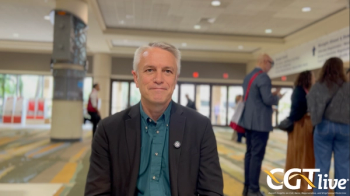
CLL1-Targeted CAR T-Cell Therapy Shows Early Promise in Pediatric AML
Results of a phase 1/2 trial show the feasibility of an approach targeting CLL1 in pediatric patients with relapsed or refractory acute myeloid leukemia.
CLL1-specific CAR T-cell therapy elicited responses in 10 of 11 (91%) pediatric patients with relapsed/refractory (R/R) acute myeloid leukemia (AML), according to a phase 1/2 trial (ChiCTR1900027684) presented at the 2021 American Society of Clinical Oncology (ASCO) Annual Meeting.1
At an interim analysis, 8 of the 10 patients experienced a complete response, with 6 also testing negative for minimal residual disease (MRD), added lead investigator Hui Zhang, MD, PhD. The remaining 2 patients had a near response and a partial response, and the final patient had stable disease.
“From all the research shown, we can say that anti-CLL1 based CAR T cells are a safe therapeutic candidate with manageable CAR T-cell–associated toxicity for children with R/R AML,” said Zhang, an assistant professor at Shanghai Children’s Medical Center and director of Guangzhou Women and Children’s Medical Center at China’s Guangzhou Medical University. “It is highly effective in targeting CLL1-positive AML cells with superior overall response rate relative to conventional/novel targeting compounds.”
Two CLL1 CAR T-cell therapies were explored in the study, both consisted of a 4-1BB costimulatory domain with a CD8 hinge. The first generation CAR was specific to CLL1 alone and was received by 8 of the patients. A second generation CAR with VL and VH variable domains for CLL1 and CD33 was administered to the remaining 3 individuals. A lentiviral vector was utilized to engineer the autologous T cells in both cases.
The 11 pediatric patients with R/R AML were aged 2 to 16 years and were infused between October 2019 and January 2021. Investigators administered a single dose of CLL1 or CLL1-CD33 dual CAR T cells (target dose: 0.3 to 1 x 106/kg) following lymphodepleting conditioning with a cyclophosphamide/fludarabine combination.
Zhang said all 11 patients experienced CAR T-cell expansion in vivo during the first month. Five patients demonstrated persistence of T-cell expansion. The duration of response reached beyond 16 months in the patient with the longest follow up, with responses ongoing in 9 of the 10 responding patients. Eight of the 10 were able to receive a subsequent potentially curative allogeneic stem cell transplant.
All patients experienced grade 1 to 3 cytokine release syndrome (CRS) but there were no lethal events, Zhang said. All patients experienced myelosuppression, which he said might be due to the conditioning chemotherapy. Three patients experienced a grade 1/2 hepatic event. No patient experienced cardiac, renal, or gastrointestinal adverse events.
Investigators have suggested that CLL1 is a promising target because it not expressed on normal hematopoietic stem cells (HSCs), but is expressed on 85% to 92% of AML blasts cells and leukemia stem cells.2 In a humanized mouse model, investigators demonstrated that CAR T-cell therapy specific for CLL1 exhibit potent cytokine production and cytotoxicity against CLL1-expressing AML cell lines without disrupting normal HSCs.
Investigators theorized that developing an anti-CLL1 CAR T-cell therapy would help patients avoid the need for HSC transplant.
In 2020, Zhang published a case study of a 10-year-old girl who presented with an elevated peripheral blood blast percentage while undergoing maintenance treatment for a B-cell ALL relapse. Investigators developed a CAR containing a CLL1-specific single-chain variable fragment.3
The patient received lymphodepleting chemotherapy for 4 days before CAR T-cell transfer to enhance in vivo expansion of CAR T-cells. This was followed by a single dose anti-CLL1 CAR-T cells infusion. She experienced grade 1 CRS.
After completing CAR T-cell therapy, the patient achieved a complete response and was negative for MRD (<0.1%) on day 29. But the CLL1+ cells were not completely eliminated until 6 months after CAR T-cell therapy. The patient achieved a 10-month response using 1 dose of anti-CLL1 CAR T-cell therapy.
References
1. Zhang H, Bu C, Pen Z, et al. The efficacy and safety of anti-CLL1 based CAR-T cells in children with relapsed or refractory acute myeloid leukemia: A multicenter interim analysis. J Clin Oncol. 2021;39(suppl 15):10000. doi:10.1200/JCO.2021.39.15_suppl.10000
2. Tashiro H, Sauer T, Shum T, et al. Treatment of acute myeloid leukemia with T cells expressing chimeric antigen receptors directed to C-type lectin-like molecule 1. Mol Ther. 2017;25(9):2202-2213. doi:10.1016/j.ymthe.2017.05.024
3. Zhang H, Gan WT, Hao, WG, et al. Successful ant-CLL1 CAR T-cell therapy in secondary acute myeloid leukemia. Front Oncol. 2020;10:685. Doi:10.3389/fonc.2020.00685
Newsletter
Stay at the forefront of cutting-edge science with CGT—your direct line to expert insights, breakthrough data, and real-time coverage of the latest advancements in cell and gene therapy.



































